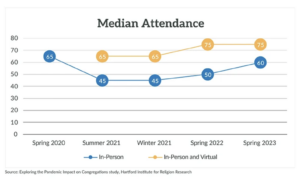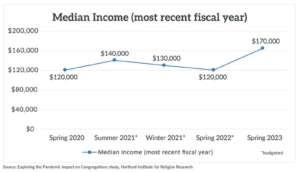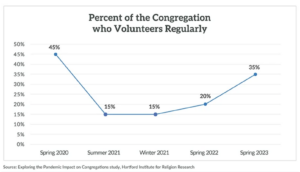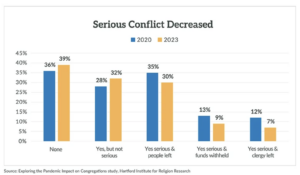Giving is Up at Churches and People are Back, but Clergy are Still Thinking About Quitting
While life at local congregations has returned mostly to normal, the future remains uncertain.

(RNS) — Three years after the start of the COVID-19 pandemic, churches have fewer people in the pews, more money in the collection plate and less conflict than they had in 2020.

Despite their struggles, many congregations are optimistic about the future. Clergy dissatisfaction, on the other hand, remains on the rise.
Those are among the findings of the latest report from the Hartford Institute for Religion Research, part of a five-year study of the impact of the pandemic on America’s churches.
This latest report drew from surveys for 4,809 congregations from 58 denominational groups, including an oversampling of 20 denominations, as part of the Exploring the Pandemic Impact on Congregations study. The surveys were fielded from January to May of 2023.
“It is apparent that congregational dynamics are still in a state of flux,” said Scott Thumma, director of the study. “Churches, and especially clergy, continue in a recovery phase. Even though aspects of church life are rebounding, the destiny of many faith communities is still uncertain.”

The median attendance at local congregations stood at 60 people as of spring 2023, down slightly from 65 in the spring of 2020, according to the report — a decline of 9%. About a third (30%) of churches said they’d experienced significant decline, while a quarter (24%) experienced some decline. Twelve percent stayed the same, while 11% said they’d experienced some growth.
One in 4 congregations (22%) had experienced significant growth.
That pattern — half of churches reporting decline while a third reported growth — is similar to the pattern at the beginning of the pandemic, according to the report.
Access to MinistryWatch content is free. However, we hope you will support our work with your prayers and financial gifts. To make a donation, click here.
Researchers also found that 16% of worship attendees were new people in 2023, up from 5% in 2020. A number of people also continue to attend services online — an average of about 25 people, according to the congregations that track their online attendance. About half of congregations do so, with a median attendance of 75 overall, including online and in-person.
“Congregations remain optimistic about the future, but it is also apparent they are continuing to wrestle with the troubling conditions that were in existence long before COVID-19 arrived,” the report’s researchers wrote.
Giving at congregations went up by about 42% over the past three years, from a median of $120,000 in 2020 to $170,000 in 2023.
“Even adjusting for inflation, this still represents a remarkable increase of over 25% since 2020,” according to the report.

Online giving appears to have played a role in boosting donations. Congregations that offer online giving reported higher per capita giving, ranging from $2,052 at congregations where online giving is used a little to $2,428 where online giving is used a lot.
Congregations that do not offer online giving options reported per capita giving of $1,809.
The report noted that only 31% of churches reported using online giving in 2015, whereas now 67% do so, and nearly half (48%) use this method “a lot.”
Researchers suspect that capital campaigns and other fundraising projects that were postponed in 2020 may have been started in 2023, boosting the giving.
Despite the boost from online donors, the return to in-person worship appears to play a role in increased giving. In congregations where there are more virtual worshippers than in-person worshippers, the median per capita giving was $1,053. In congregations where most of the attendees are in person and few are virtual, giving was $2,479 per capita.
“Whatever the reasons for the rise, it will be interesting to watch this trend in future surveys,” researchers wrote. “This is especially true since the growth in income did not translate into a significantly more positive assessment of the congregation’s financial health compared to their self-perception of five years earlier.”
Giving to religious groups — including congregations and other faith-based charities — grew by 5.2% in 2022, according to the Giving USA report. Those donations made up about a quarter (27%) of all giving to charity — and religion was the only sector in the Giving USA report where giving went up.

While online worship persists, other forms of activities — such as youth programs, adult education and prayer groups — that were held online during the pandemic are now mostly in person.
“Half of churches are not holding any small groups or Bible studies online, 40% do not use online platforms for their administrative and committee meetings, and 40% have no e-newsletter,” according to the report.
In other findings, volunteerism is bouncing back, with congregations reporting that a third (35%) of their members volunteer regularly, up from 15% in 2021 and 20% in 2022. That number, however, does not match the 45% who volunteered in 2020.
Conflict at congregations has also declined, with 7% reporting that conflict was so serious that clergy left, 9% saying people withheld funds due to conflict and 30% saying people left due to serious conflict. In 2020, 12% of congregations reported that clergy left due to conflict, 13% said people withheld funds due to conflict, and 35% said people left.
Thirty-nine percent said there was no serious conflict in 2023, up from 36% in 2020, while 32% said there was conflict but it was not serious, up from 28% in 2020.

Almost half of congregations (45%) said they were very positive about the future, while a third (36%) were somewhat positive. Nine percent were somewhat negative and only 2% said they were very negative.
However, the percentage of clergy who have thought about leaving both their church and the ministry altogether has risen since 2020.
In 2021, most clergy in the survey (79%) said they had never thought about leaving their current church, while 13% said they thought often about leaving. In 2023, the number who never thought about leaving had dropped to 62%, while 29% said they thought about it often.
As for leaving the ministry altogether, two-thirds of clergy (62%) said in 2021 that they had never thought about doing so, while 27% said they thought about it often. In 2023, 49% said they never thought about leaving, while a third (34%) have thought about it often.
Congregations also have less enthusiasm for change, three years after the start of the pandemic. In the summer of 2021, 86% of congregations said they were willing to embrace change in order to meet their challenges — including 47% who strongly agreed that they were willing to change. In 2023, two-thirds (66%) were willing to change — with only 20% strongly agreeing.
Researchers said congregations appear to be hopeful that they can face the challenges ahead of them. But those challenges are significant.
“Amid these positive signs remain some structural and organizational challenges that indicate all is not entirely rosy. Even given the rebounding attendance and level of optimism, the broad pattern of considerable membership decline remains ever-present.”
Main photo: Photo by Allef Vinicius/Unsplash/Creative Commons



